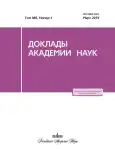A comparative analysis of the interaction regimes of two drops and their large population in an aerosol cloud
- Authors: Vysokomornaya O.V.1, Rebrov A.K.2, Strizhak P.A.1, Shlegel N.E.1
-
Affiliations:
- National Research Tomsk Polytechnic University
- Kutateladze Institute of Thermophysics, Siberian Branch of the Russian Academy of Sciences
- Issue: Vol 485, No 1 (2019)
- Pages: 38-43
- Section: Mechanics
- URL: https://journals.eco-vector.com/0869-5652/article/view/12811
- DOI: https://doi.org/10.31857/S0869-5652485138-43
- ID: 12811
Cite item
Abstract
A comparative analysis of experimental results obtained by different researchers using two different experimental approaches is presented: phenomenological (registration of conditions, characteristics and modes of interaction between a drop of a shell and a target drop) and statistical (analysis of collisions of tens and even hundreds of drops of liquids as part of an aerosol). The ranges of Weber criterion values (the basic parameter used for analyzing the effects of collisions of droplets in a gaseous medium) are established, corresponding to bounce, coalescence, reflexive and stretching separation, disruption, according to the results of all considered experimental research. The bounce of droplets upon collision can be observed under the conditions We = 0.35–0.5; the probability of droplet coalescence is maximum in the range We = 1–7.5; it is possible to reliably predict spreading at We = 15–50; splitting of droplets most often occurs at values We > 50. The probability of occurrence of other scenarios in the selected We ranges is not zero. The conclusion about the need to combine experimental techniques to obtain the most reliable data and their further use in the development of prognostic models is formulated.
About the authors
O. V. Vysokomornaya
National Research Tomsk Polytechnic University
Author for correspondence.
Email: vysokomornaja@tpu.ru
Russian Federation, 30, Lenin Avenue,Tomsk, 634034
A. K. Rebrov
Kutateladze Institute of Thermophysics, Siberian Branch of the Russian Academy of Sciences
Email: vysokomornaja@tpu.ru
Academician of the RAS
Russian Federation, 1, Academic Lavrentiev Avenue, Novosibirsk, 630090P. A. Strizhak
National Research Tomsk Polytechnic University
Email: pavelspa@tpu.ru
Russian Federation, 30, Lenin Avenue,Tomsk, 634034
N. E. Shlegel
National Research Tomsk Polytechnic University
Email: pavelspa@tpu.ru
Russian Federation, 30, Lenin Avenue,Tomsk, 634034
References
- Paruchuri S., Brenner М. Р. // Phys. Rev. Lett. 2007. V. 98. Article ID134502.
- Eggers J., Villermaux E. // Rept. Prog. Phys. 2008. V. 71. ID036601.
- Sprittles J. E., Shikhmurzaev Y. D. // Phys. Ffluids. 2012. V. 24. 122105.
- Varaksin A. Y. // High Temp. 2013. V. 51. P. 377-407.
- Sazhin S.S. // Fuel. 2017. V. 196. P. 69-101.
- Кузнецов Г. В., Волков Р. С., Стрижак П. А. // Письма в ЖТФ. 2015. Т. 41. № 17. С. 53-60.
- Антонов Д. В., Волков Р. С., Кузнецов Г. В., Стрижак П. А. // ИФЖ. 2016. Т. 89. № 1. С. 94-103.
- Архипов В. А., Ратанов Г. С., Трофимов В. Ф. // ПМТФ. 1978. № 2. С. 73-77.
- Архипов В. А., Васенин И. М., Трофимов В. Ф. // ПМТФ. 1983. № 3. С. 95-98.
- Пажи Д. Г., Галусто В. С. Основы техники распы- ливания жидкостей. М.: Химия, 1984.
- Orme M. // Prog. Energy Comb. Sci. 1997. V. 23. № 1. P. 65-79.
- Pawar S.K., Henrikson F., Finotello G., Padding J.T., Deen N.G., Jongsma A., Innings F., Kuipers J.A.M.H. // Powd. Tech. 2016. V. 300. P. 157-163
Supplementary files








